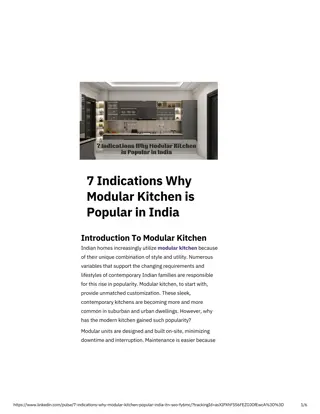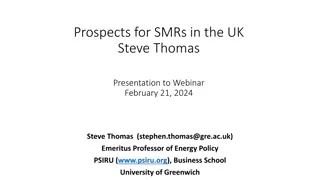Modular Performance Reasoning of Data-Intensive Programs by Yu David Liu
"Explore how programming language techniques can optimize the performance of data-intensive software. Key questions include achievable data rates, input-output relationships, and program structures for reasoning."
Download Presentation

Please find below an Image/Link to download the presentation.
The content on the website is provided AS IS for your information and personal use only. It may not be sold, licensed, or shared on other websites without obtaining consent from the author.If you encounter any issues during the download, it is possible that the publisher has removed the file from their server.
You are allowed to download the files provided on this website for personal or commercial use, subject to the condition that they are used lawfully. All files are the property of their respective owners.
The content on the website is provided AS IS for your information and personal use only. It may not be sold, licensed, or shared on other websites without obtaining consent from the author.
E N D
Presentation Transcript
Modular Performance Reasoning of Data-Intensive Programs Yu David Liu State University of New York (SUNY) at Binghamton FOAL 2015
Modular Performance Reasoning of Data-Intensive Programs Yu David Liu State University of New York (SUNY) at Binghamton FOAL 2015
Modular Performance Reasoning of Data-Intensive Programs Yu David Liu State University of New York (SUNY) at Binghamton FOAL 2015
Modular Performance Reasoning of Data-Intensive Programs Yu David Liu State University of New York (SUNY) at Binghamton FOAL 2015
Modular Performance Reasoning of Data-Intensive Programs Yu David Liu State University of New York (SUNY) at Binghamton FOAL 2015
Data Intensive Applications On the rise High-performance requirement 6
Motivating Question I Can programming language techniques help understand and optimize performance of data- intensive software? 7
Performance Question 1 Is this data rate achievable and sustainable? ? 8
Performance Question 2 Given an Input data rate, what will the output rate be? ? 9
Performance Question 3 Given a desired output rate, what input rate is required? ? 10
Performance Question 4 Given unlimited Input data, how fast can the output rate be? ? 11
Motivating Question II Can program structures help reason about performance of data-intensive software modularly? 12
This Talk: Rate Types A type system to reason about data rates in data intensive applications Bartenstein, Liu, Rate Types for Stream Programs (OOPSLA 14) 13
Motivating Question Revisited Can program structures help reason about performance of data-intensive software modularly? What programming models? (an open question in the long term) 14
Stream Programming A well-known paradigm classic data-flow model (e.g. Lucid) + high-throughput data processing Many recent examples from both PL and database communities StreamIt, Streamflex, Aurora, Borealis, Pig Latin, Bamboo, FlumeJava . The latest Java has stream support 15
Stream Programming: Filters and Streams Streams: Sequence of Data x=Pop() , 31, 24, 17, 10 , 28, 21, 14, 7 x=x+3 Push(x) Filters: Consume data from an input stream Process Data Produce data on an output stream 16
Stream Programming: Combinators chain fork-join feedback 17
Stream Programming Benefits Friendliness to Big Data applications High parallel efficiency Task Parallelism Data Parallelism Pipelining Programming abstractions friendly for performance reasoning (as we shall see) 18
Rate Types A type system to reason about data rates of stream programs 19
Stream Rate Insight Output Data rate depends on input data rate 20
Stream Rate Insight until 21
Stream Rate Insight processing time becomes the bottleneck; Output rate is proportional to processing time. 22
Input / Output Rate Graph Input vs. Output Rate 3.5 3 OUTPUT DATA ITEMS PER SECOND 2.5 2 Where does it plateau? 1.5 1 What s the slope? 0.5 0 0 1 2 3 4 5 6 7 INPUT DATA ITEMS PER SECOND 23
4 3 Rate Types 2 1 0 0 2 4 6 Slope is the throughput ratio - ratio between the output rate and input rate Plateau is the natural bound - output rate given unlimited input rate Rate type is the tuple 24
Input / Output Rate Graph Input vs. Output Rate 3.5 3 OUTPUT DATA ITEMS PER SECOND 2.5 = 3 2 1.5 1 = 1 0.5 0 0 1 2 3 4 5 6 7 INPUT DATA ITEMS PER SECOND 25
Stream Programming: Combinators chain diamond circle 26
Chain Combinator Type Checking PA PB 27
Chain Combinator Type Checking Pa Pb 28
Diamond Combinator Type Checking 5 3 2 PA PB 1 2 3 29
Circle Combinator Type Checking Complex because of feedback Intuitively 1 1 inverted diamond fix point 2 PA PB 2 1 1 30
Base Case: Filter Type Checking 2 3 filter time 31
Subtyping Input vs. Output Rate 3.5 =1, =3 3 OUTPUT DATA ITEMS PER SECOND 2.5 2 1.5 1 =0.5, =2.125 0.5 0 0 1 2 3 4 5 6 7 INPUT DATA ITEMS PER SECOND 32
Why Types? A Unified Solution Type Checking: ? Type Inference: ? ? Principal Typing: ? 33
Why Types? Modularity Thanks to its type system formulation, a distinctive trait of Rate Types for performance reasoning is it promotes modular reasoning Partial stream graph reasoning: no need to have all filters implemented to reason about the data rate of the entire program. Plug-in stream subgraphs as long as they conform to the throughput ratio and natural bound specified on the signature 34
(Rate Types) Operational Semantics Data-aware: correct bean counting on input/output data items in the stream Time-aware: tracking filter/graph processing times Parallel-aware: supporting parallel execution among filters An abstract machine with minimal assumptions: No (requirement on) synchronizing clocks Working with arbitrary schedules 35
Why Types? Provable Correctness Soundness: if the type system says rate x can be achieved, a reduction sequence exists Completeness: if the type system says rate x cannot be achieved, no reduction sequence with rate x exists 36
Why Types? Provable Correctness Type inference is sound relative to type checking Type inference is complete relative to type checking Principal typing always exists 37
Implementation StreamIt base Calculate principal rate types Control Input rate Measure Output rate Run benchmarks 4 Micro-benchmarks 6 StreamIt benchmarks 200 input data rates Graph Expected vs. Measured 38
Rate Types Generality Potential generalizations to systems such as Aurora, Bamboo, StreamFlex, and may further have applications in FRP-like languages where signal sampling rates matter Limitations include Assumes declarative push and pop counts for filters Assumes stable filter level profiling Current/Future work includes hybrid typing handle dynamic fluctuations improve adaptiveness A Java-based framework 39
Rate Types in Retrospective Can program structures help understand performance of data- intensive software? Rate Types provides a unified and modular reasoning framework for performance of data-intensive software surprising how much we can statically answer questions that appear to be inherently dynamic 40
Bigger Picture Non-functional properties such as performance and energy are critical and well-studied in experimental research (OSDI/SOSP, ASPLOS, ISCA, SIGMOD, SC, etc) reasoning about non-functional properties 41
Thank You 42























